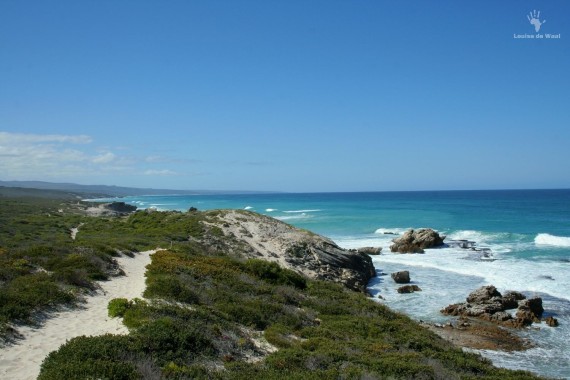5 Fabulous attractions in De Hoop besides whales
De Hoop Nature Reserve in the Overberg is one of my treasured short break destinations from Cape Town. Why? Because no matter what time of year, De Hoop always delivers beyond expectations.
This little piece of paradise is best known for its excellent land-based whale watching, while sitting on top of Koppie Alleen. During the Cape winter months (June-November) Southern right whales can be seen in the marine protected area along its coast. They are easily recognisable by their V-shaped blow and the large whitish callosities on their heads.
At the end of the summer, the Southern right whales migrate from the Southern Ocean near Antarctica, to spend the cold winter months in the warmer and calmer waters around South Africa. Here, mothers give birth and nurse their calves, while others mate.
Sitting on top of this pure white sand dune, within minutes you will spot scenes of mothers interacting with their calves, large males breaching over and over again, and playful mating rituals. Before you realise, you are witness to a truly magnificent sight – 40+ whales swimming slowly along De Hoop’s coastline.
But De Hoop offers so much more than sea, sand and whales…
1. Cape Vultures at Potberg
One of De Hoop Collection’s latest guided activities is a trip to the cliffs of the Potberg mountains. Here, you can see the Endangered Cape vulture with a wingspan of about 2.5 m, gliding on the thermals and slowly circling overhead. The vulture viewing platform is reached after a one-hour hike through the Fynbos.
Once near extinction in the Western Cape, Potberg is the only breeding colony of about 200 vultures left in our Province. These large birds roost and nest on the steep cliffs of this pretty gorge together with Peregrine falcon, Verreaux’s eagle, Jackal buzzard and Rock kestrel. Vultures are typical scavengers, feeding on fresh dead animals, but their numbers are seriously declining through habitat destruction, poisoning incidents by farmers, and trapping and poisoning of vultures for the muti market.
In the Overberg however, farmers work together with CapeNature providing fresh livestock carcasses for the “vulture restaurants” – safe places for the birds to feed without human disturbance.
2. Interpretive Marine Walk
During low tide, De Hoop Collection offers a 2 hrs interpretive marine walk through the intertidal zone. We were lucky enough to be guided by Dalfrenzo Laing with his contagious passion and enthusiasm.
The intertidal zone is the area bordering the beach, submerged during high tide and more or less above water at low tide. An area of extremes with vastly fluctuating water levels, salinity levels, temperature ranges, and wave action. Hence, many of the species are highly adaptable and often have the ability to attach themselves to the rocks and/or are protected by hard shells, like seaweeds, abalone, anemones, limpets, mussels, sea cucumbers and star fish.
In his own unique way, Dalfrenzo explains the various intertidal zones, comparing them to South African residential areas. This walk brought back memories of many happy family holidays, spending hours with a bucket, spade and a net exploring rock pools and collecting shells.
3. Vlei Eco-Cruise
Take a gentle morning or afternoon cruise on the De Hoop Vlei, while enjoying coffee or tea with pastries and croissants (morning) or yummy snacks and wine (afternoon). The vlei area is a Ramsar site (wetland of international importance) fed by underground springs and the Sout and Potteberg rivers, and is completely separated from the ocean by sand dunes.
Discovering the reserve from the water, gives yet another perspective of De Hoop – this time birds. Of the 260 bird species recorded at De Hoop, nearly 100 are waterbirds and birds that are dependent on the vlei, including the Greater and Lesser flamingo, Great white pelican, Yellow-billed duck, Cape shoveler, Red-knobbed coot, and Egyptian goose.
4. Nature R&R
One of the things I love most about De Hoop is its diversity – beach, ocean, dunes, mountains, Fynbos, wildlife, birds – all within easy reach and accessible by foot, bike or car.
Take an easy hike around the vlei area, especially beautiful in Spring during the Flower Season. You will have a good chance to see Eland, Cape mountain zebra, the rare Bontebok, and Ostrich, as well as a range of waders. Alternatively, take an energising walk along part of the Whale Trail, while watching baboons play in the dunes and whales in the sea.
5. De Hoop Spa
Being treated to a relaxing massage or cleansing facial treatment at the De Hoop Spa is a fabulous extension to its more nature-based activities. What more can I say though? The combination of a spa treatment, sitting at the pool with a glass of bubbles, while overlooking the Vlei after a hard day at work exploring the reserve, is pure bliss.
This trip was made possible by De Hoop Collection and organised by Theresa Gibbon PR. For further information on accommodation and activities at De Hoop please check HERE.






























